Bellprat, Catalonia, Spain
In many ways, this small village is the ideal book town. It is in a beautiful rural setting in Catalonia’s Anoia region, yet only 90km from Barcelona. It has an appealing medieval centre and its population is enthusiastic about throwing open its doors to book-loving visitors. Bellprat is also the first book town in Catalonia (the second in Spain, after Urueña).
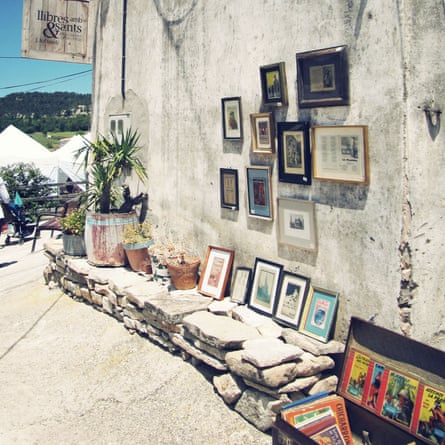
During the town’s main festival – on the first weekend in June – several village houses are temporarily turned into secondhand bookshops, to complement the many stalls set out in a covered market. The books on sale are overwhelmingly in Catalan, however. As well as promoting the village, the book town label is used for good causes: at a recent festival, there was a book swap in which books could be exchanged in return for donations to a food bank. Other book-based events range from conferences, round tables and readings to events run by independent regional publishers.
The atmospheric Cal Pinyota on Plaza Catalunya (on Airbnb) is a bookshop-hotel with bedrooms on various themes, including the detective novel (with a special nod to the region’s most famous fictional detective, Pepe Carvalho), historical fiction, and travel. It also organises creative writing workshops and themed literary weekends for families, with suggested reading lists, treasure hunts and craft sessions.
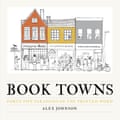
This is very much a community-run book town. From simple beginnings in 2008, when it was set up by the L’Associacio d’Amics de Bellprat (Association of Friends of Bellprat), it now offers visitors more than 20,000 books for sale. This is impressive given the population of the village is under 100.
The nearby towns of Cervera, near Lleida, and Montblanc near Tarragona are also being developed as part of the Viles del Llibre (Book Villages) project to help depressed areas build a sustainable economy. And there are plans to keep the expansion going, opening four more book towns before 2020.
viladelllibre.cat
Fontenoy-la-Joûte, France
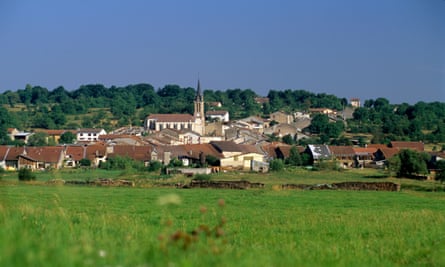
Before it became a book town Fontenoy-la-Joûte, 100km west of Strasbourg, had no connection with the literary world and indeed few book businesses of any kind. It set up Les Amis du Livre, with the aim of promoting reading and writing in 1994. The book town was officially inaugurated two years later, thanks to the efforts of a small band of enthusiasts, including France’s former agriculture minister, François Guillaume, and the village mayor, Jean-Marie Vanot.
Eighteen businesses opened in April 1996, with bookshops planning to open at weekends and holidays, and more frequently during the summer. Within four years the project had renovated 24 buildings for new use. At its height there were 23 booksellers in the village and its first book fair, in September 1994, attracted around 11,000 visitors, as well as booksellers from France, Belgium and Luxembourg.
There are still 10 bookshops and a calligraphy studio – L’encre et l’Image on Rue Saint-Pierre – and Fontenoy attracts peripatetic art festivals such as Apprentiss’ART, which in 2016 put on a display of literary origami. It has also held an annual writing contest for the past two decades, with the winning entries published in a short book.

An unusual signpost in the village centre points to other book towns around the world, plus imaginary locations including Atlantis and Edgar Rice Burroughs’ fictional Pellucidar.
The oldest bookshop in Fontenoy is the marvellously named A la recherche du Livre Perdu (In search of the lost book) on Rue Saint-Pierre. Also dating back to 1996 is Le Chat Botté on Rue Division Leclerc, which has a huge arched doorway and natural stone wall interiors.
L’Etable majors on comic books, while Paragraphes and Nuit de Chine (both on Rue Division Leclerc) are good for children’s books. La Forge 54’s focus is architecture and esoteric subjects, and Librairie Viollet’s is history and posters. La Porte Retrouvée, formerly N’en faites pas un roman (Don’t write a novel about it), is strong on science fiction and also has a good selection of vinyl records.
villagedulivre54.fr
Gold Cities, California, US

The Gold Cities Book Town in California was set up in 1997 – again inspired by a trip to Hay-on-Wye – largely by local book folk Gary Stollery and John Hardy. It actually covered two main locations, Grass Valley and (four miles to the north) Nevada City, with satellite sellers in nearby Penn Valley, North San Juan and Lake of the Pines, and at its peak had more than 30 bookshops.
Despite this promising start, and the launch of an annual Gold Rush Book Fair, bookshop numbers have declined. However, in Nevada City, Stollery still runs a bookshop, Toad Hall Books (North Pine Street), with his wife Clarinda, while Hardy Books, open by appointment only, still specialises in western Americana and all things Californian, much of which is not included in its online inventory.
Jenny’s Paper & Ink Books (on Joerschke Drive in nearby Grass Valley) offers preowned delights, and at the other end of town is Booktown Books, a co-operative established by a group of dealers in 1998. The project has gradually expanded, and since 2005 has operated from a substantial two-storey building. Each bookseller has their own booth: Bud Plant and Hutchison Books, for example, specialise in fine illustrated and children’s books in Booths 8 and 10. Main Street Antiques & Books has a booth here, as well as a shop in Nevada City.
Round the corner from Jenny’s The Open Book was established in 1994, originally as Tomes Bookstore. Since 2015 it has been run along collective lines, with volunteers working regular shifts and organising evening events. Volunteer privileges include unlimited book borrowing. The Open Book is also home to independent publisher The Open Book Press.
booktownbooks.com, theopenbookgv.com
Lilleputthammer, Norway

All book towns sell children’s books, and some booksellers focus entirely on titles for young people, but there is only one children’s book town – Lilleputthammer in Norway. Lilleputthammer is a small adventure park for families. The main section is a miniature copy of the main street in the city of Lillehammer, Storgata, with all the houses built as they looked in the 1930s but at a quarter size. There are more than 40 shops, two hotels, three cafes, two bakeries, a police station and a cinema. Within this is the Children’s City of Books – six houses devoted entirely to books.
“We have about 15,000 books in different genres, all for children,” says Cathrine Wilhelmsen, its deputy manager. “The books are divided into different houses according to the ages of the readers and then again into categories such as animals, fairytales, environmental protection, cowboys, crime, nature and outdoor living. The houses are When Mum and Dad Were Young (books written between 1900 and 1970), Picture Book House, Youth Literature, Mysteries and Crime, The Comics House, and The House of Facts. We also have a bookshop with new books, stationery, art and fun stuff.”
lilleputthammer.no
Biblo Tøyen, Oslo

This children-only library is aimed at 10-15 year olds; adults are not allowed in and must wait outside for their offspring to emerge. The library is run along normal lines, with library cards for borrowing books, and caters particularly for children. after the school day is over.
The layout and decor are anything but normal, though. After consulting young readers in focus groups, the designers have installed a Volvo truck with a functional kitchen in the back (the library also runs activities including cookery courses) and a reading sofa under the bonnet. Library users can also enjoy their books in a ski-lift gondola hanging from the ceiling, a converted tuk-tuk, a barber’s chair, or numerous wheelbarrows. Books are arranged by themes, which means no book has a fixed location. At night, a dedicated book drone flies around the library to scan and update the books’ positions.
deichman.no
Montereggio, Italy
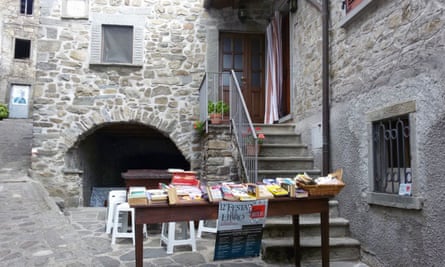
The history of bookselling in the hilltop village of Montereggio in Tuscany goes back centuries. Indeed, the first printing press was operated in the town by Jacopo da Fivizzano in 1471 and the first bookshop was opened there in the late 1490s. Over the next 100 years, local residents – sometimes entire families – began to operate as itinerant booksellers, toting huge wicker baskets of books around the fairs and markets of central and northern Italy.
The work of families such as the Bertoni, Fogola, Ghelfi, Giovannacci, Maucci, Lazzarelli, Lorenzelli, Rinfreschi, and Tarantola is remembered in the many streets named after them throughout the town. In 1952, Montereggio hosted the inaugural Premio Bancarella, Italy’s leading literary prize.
As well as books, the roaming salesmen and women also sold knives and other tools from their baskets. As the number and weight of the books increased, the sellers turned to using carts pulled by hand or horse. Today, this history and the town’s ongoing book activities are supervised by the volunteers of Le Maestà di Montereggio, founded in 2013.
By the time of Italian unification, intellectuals and richer members of society became particularly good customers, interested in banned books the ambulant booksellers were able to bring over the border from other countries. “The most requested books were those written by Mazzini, D’Azzeglio, Cattaneo, Rossetti, Pellico and Balbo, but also erotic and romantic novels and books by Macchiavelli and Voltaire,” says Giacomo.
Today, this village of just 50 inhabitants hosts a huge book fair every August and a prestigious illustrated book award, the Silent Book Contest. In addition to the several bookshops there are also many honesty shops, with piles of books arranged in niches and on tables around Montereggio.
montereggio.it
Óbidos, Portugal
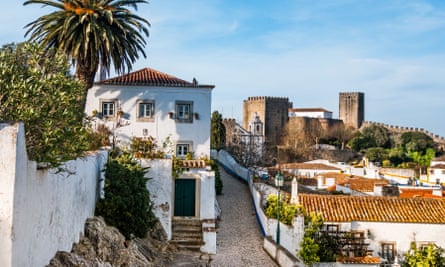
Óbidos is a beautiful, historic hilltop town with a wall that encloses a compact medieval centre filled with cobbled streets and traditional houses. The town – just over an hour north of Lisbon – was previously best-known for its annual chocolate festival and as the home of the cherry-based liqueur, ginjinha. Then José Pinho, owner of Lisbon bookshop Ler Devagar (Read Slowly), had the idea to change Óbidos into a book town.
Óbidos stands out from most other book towns in that it didn’t open new bookshops; many stores have simply added bookselling to their business. So, the local art galleries sell art books, the Óbidos organic market has shelves of cookbooks behind its fresh fruit and vegetables, and the museums stock history, interior design and heritage titles, according to their individual focus.
The Literary Man hotel on Rua Dom João de Ornelas (doubles from €85 room only) is run by the town’s former mayor, Telmo Faria, and has merged accommodation and literature particularly well. Around 50,000 books are for sale, spread around the 30-bedroom property. Some books are in Portuguese but most in English, with an emphasis on Penguin, Pelican and Pan Books.
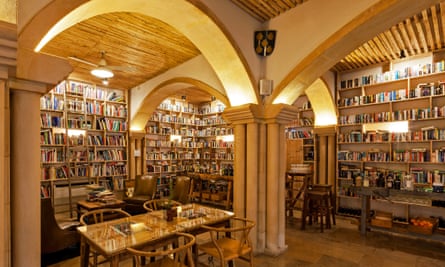
One of the most stunning bookshops is the Grande Livraria de Santiago, inside the town’s 13th-century church next to Óbidos castle. Books in various languages crowd are piled on former altars, and bookshelves have replaced pews. O Bichinho do Conto (Estrada dos Casais Brancos) is the country’s first bookshop devoted to children’s titles, and is in a former primary school.
Óbidos hosts a major international literary festival, Folio, attracting highly regarded authors such as Salman Rushdie and VS Naipaul and featuring reading marathons, concerts and screenings. Other projects include a scheme for turning abandoned houses into live-work spaces for writers, artists and other creative entrepreneurs.
The oldest bookshop in the world
According to Guinness World Records, Livraria Bertrand in Lisbon is the world’s oldest bookshop still in operation. It was established in 1732 (though it moved in 1755 after earthquake damage, before returning to Rua Garrett in the Chiado area) by Peter Faure, and became an important hangout for intellectuals and writers. Pierre Bertrand joined Faure in 1742 and also married his daughter, taking over (and renaming the shop) with his brother Jean Joseph when Faure died in 1753. An expansion programme started in the 1960s and it now operates a chain of more than 50 bookshops around the country.
Paju, South Korea
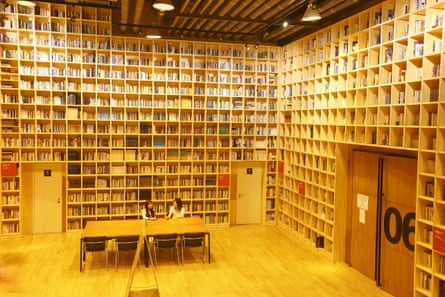
Paju Book City stands alone among members of the International Organisation of Book Towns in that while it has bookshops, book cafes and publishers, it has nothing else. Every single building and person here is dedicated to making, publishing, selling and promoting Korean books.
It is also in the most unlikely setting of any book town: a reclaimed marshy flood plain near the Demilitarized Zone, just half a dozen miles from the border with North Korea. Indeed, its location was a guiding principle by the founding publishers, who wanted to emphasise the importance of the common good above self-interest. While at its heart was a commitment to print, the plan was to build somewhere as an antidote to the perceived over-development of Seoul.
Since 1989, major international architects and designers have been turning Paju into a unique site. There is a traditional Korean hanok house at its centre, a symbol of the goal to ensure Paju is in harmony with its surroundings. It has been criticised as a slightly sterile industrial park but others have applauded its quiet, tree-lined, largely traffic-free streets dotted with wooden benches, and its unusual features, such as the miniature railway which runs around the children’s bookshop Alice’s House.
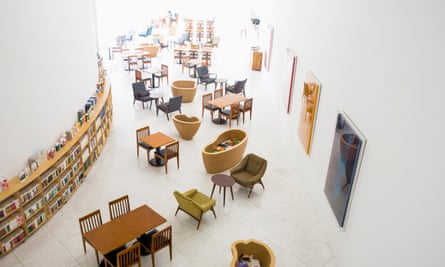
There are book cafes everywhere, including the popular Hesse on the third floor of the Pinocchio Museum (Hoedong-gil). The vast Book House Foresta (Heyri) is a cultural arts complex on three floors where browsers can sip house-roasted coffee against a backdrop of floor-to-ceiling bookshelves.
It was the brainchild of publisher Yi Ki-Ung but is now owned by the Ministry of Culture, Sports and Tourism. Today there are around 250 publishers based in Paju and 10,000 people working here (few live here and most commute in, some in special buses owned by publishers). It is divided into three zones: a publishing district, a printing district and a support district. Books (mostly Korean but some in English and Japanese) are sold from the ground-floor premises of various publishing companies as well as in bookshops. Along with its annual Booksori book festival, which attracts up to half a million visitors to a week-and-a-half of events, there are the Paju book awards for Asian writers, editors and designers for promoting the region’s culture.
The Forest of Wisdom (Hoedong-gil) has eight-metre-high shelves and a collection of 50,000 donated books, many provided free by academics and other specialists. Volunteer advisers help readers search the stacks, and there is also an on-site hotel, so visitors can read books 24 hours a day. Lectures and book clubs are run throughout the year, and in May Paju hosts a children’s book festival.
pajubookcity.org
Torup, Denmark
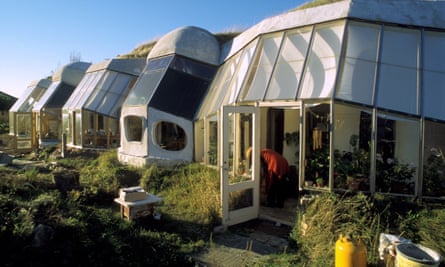
Torup is unusual even for a book town. There are two parts to the Danish community of around 300 residents: the old part (a village since the 11th century); and a new zone that, since the 1990s, has been home to an eco-village called Økosamfundet Dyssekilde.
The original idea behind Økosamfundet Dyssekilde was to create a vegetarian, spiritual and humane village, though the focus is now more on a shared foundation of values than a single idea. The village is divided into six semi-autonomous groups who are responsible for the outdoor area between the homes and who manage their own budgets and social events.
University lecturer and resident Peter Plant, now the book town’s chairman, heard a radio programme about Fjærland, a book town in Norway and believed it would be a good fit for Torup. There was then a visit to Tvedestrand, also in Norway, and Torup bogby (Danish for book town) was set up in 2006, with 2,000 people attending its first summer festival.
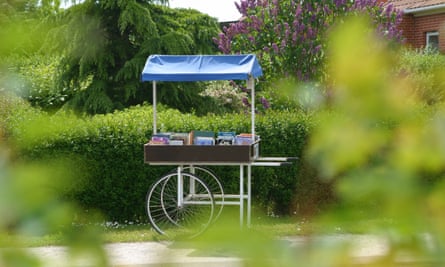
Five book wagons – carts on wheels with canopies – were set up in 2007 to sit at roadsides for self-service use and these were joined by a book cafe in a greenhouse at the health food store Taraxacum. A year later the village held its first workshop for aspiring writers. There are now a dozen book carts and places to buy books around town.
In 2010 Torup became a member of the International Organisation of Book Towns and in 2011 the restored former railway station, dating from 1916, became the book town’s headquarters. There is now a bookstore on the ground floor as well as local food for sale and a bicycle rental station.
Visitors will find mini bookshops in garages, a workman’s hut, a disused stable, a farm entrance, in front of the church and by the entrance to the supermarket. There are plenty of ingenious shelving ideas too: books stacked in bread boxes and milk crates. Some operate on a self-service honesty basis. The association also runs a yearly Nordic Book Festival, with talks and readings from established authors, along with live music.
torupbogby.dk
Bredevoort, Netherlands

Photograph: Alamy Stock Photo
Bredevoort is in the Netherlands’ Aalten region, close to the border with Germany. It became a book town in 2003 and at its height had around 30 bookshops and book-related businesses. It was a founding member of the International Organisation of Book Towns. Today there are just half of that number.
Local historian and teacher Henk Ruessink was instrumental in getting the book town off the ground, following a major restoration of Bredevoort’s medieval centre. Inspired by a trip to Hay-on-Wye, and with the backing of local authorities, he contacted hundreds of booksellers in Germany and the Netherlands and held a special open day to sell the concept.
As well as their general stock, most of the bookshops also specialise. The English Bookshop in history, English literature and illustrated books; Scrinium in Greek and Latin; The Old Motor Bookshop in car and tractor books and Boek en Zo in mathematics, physics, chemistry, astronomy, medicine and biology.

The town also has numerous honesty bookshops. Among them is one outside Horus Huiskamertheatertje, on Hozenstraat, which claims to be the smallest theatre in the Netherlands (it seats 14) and puts on shows by storytellers, poets and musicians. Chartae Laudes, on Koppelstraat (open on the third Saturday afternoon in the month and by appointment), also provides book-related services including restoration, bookbinding and handmade decorative papers.
Every third Saturday there is a book market in the tree-lined ‘t Zand Square, with bookbinding demonstrations. There is also a tradition of book fairs in May and August, which attract dealers from Germany, Belgium and the Netherlands, and another at Easter for discounted books. Bredevoort is also home to the thriving Boekencafé, run from the town’s former Koppelkerk church, now a cultural centre.
boekenstad.com
College Street, Kolkata

Towards the end of the 18th century, Kolkata became a major printing centre, thanks to the East India Company, which built up the industry for commercial reasons. It has retained that pedigree, and the International Kolkata Book Fair, established in 1976, is now the world’s biggest book fair for the general public.
Though not an actual town, College Street, in the northern, older part of the city has turned itself into a haven of bookselling. Known locally as Boi Para (Colony of Books), it is regarded as the largest secondhand book market in the world. Around 1.5km long, and running from Mahatma Gandhi Road to Ganesh Chandra Avenue, it is home to a long stretch of street stalls, traditional bookshops, publishers, and educational institutions.
Some of the booksellers claim a family tradition going back more than 100 years. The stock is eclectic: especially good for textbooks, it also stocks fiction and non-fiction, pamphlets and other printed ephemera, largely in Indian languages (particularly Bengali) and English. Combined with the street’s busy, often chaotic, character, it makes for a colourful browsing experience.
Among the bricks-and-mortar bookshops are the National Bookstore (opposite the Presidency University), Dasgupta & Co (College Street’s first bookstore, set up in 1886) and Bani Library (a family-run business for five generations). One of the most famous landmarks along College Street is the Indian Coffee House, opposite the Presidency University, part of a chain owned and run as co-operatives by its employees. Though not noted for its coffee, it does have a long history as a meeting place for intellectuals, artists, and politicians, as well as local students.


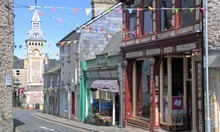
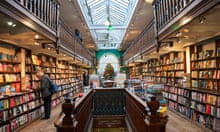
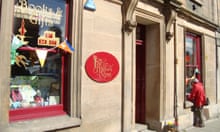


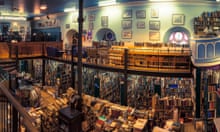
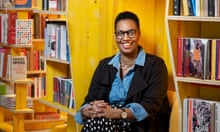

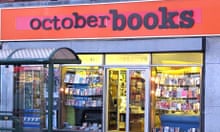
Comments (…)
Sign in or create your Guardian account to join the discussion